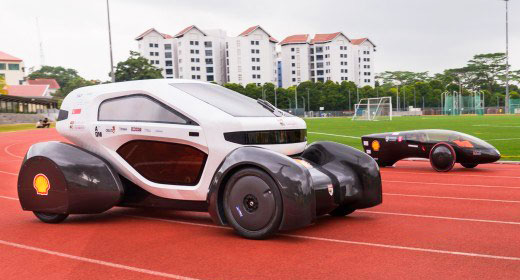Students at Singapore’s Nanyang Technological University have built the island republic’s first 3D-printed concept car.
The NTU Venture 8 (NV8) is built on a carbon fiber single-shell chassis.
Its 150 3D parts were made out of lightweight plastic that were created on printers at the university, 3D printer manufacturer Stratasys, and the Singapore-MIT Alliance for Research and Technology.
The vehicle has a honeycomb structure and is partially powered by solar cells designed to flow with the shape of the chassis. It’s an “urban concept” car that can hit 60 kph, or about 40 mph., told TechNewsWorld.
It’s not possible to physically 3D print an entire car, including electronics, tires and everything else, but “I expect that 3D printed accessories for the passenger cabin, in metal as well as plastic, will be the first practical uses of 3D printing in automobiles, trucks and other vehicles,” Basiliere said.
Safety Issues
The NV8 weighs 120 kg, or about 260 lb. Compare that to the 2012 Smart Fortwo, which weighs in at 1,808 lbs, or the 2012 Mini Cooper hatchback, which tips the scales at 2,535 lbs.
That could be a problem. Due to its light weight, the NV8 would not only be unsafe on the roads, but would also be able to carry only relatively light passengers.
Research into creating safe, lightweight cars is ongoing. A European consortium is investigating the use of graphene-based materials to enhance both vehicle and occupant safety while remaining very light.
However, safety boils down to simple physics: A larger, heavier vehicle will, through its sheer mass and weight, severely damage a smaller, lighter one, no matter how strong the latter is. Put another way, there’s no doubt of the outcome of a collision between a flabby elephant and the world’s strongest man.
One Among Many
The NV8 is by no means the first concept vehicle whose body was made using 3D printers.
“The 3D-printed car at CES 2015 was likely a better all-around vehicle,” Rob Enderle, principal analyst at the Enderle Group, told TechNewsWorld.
He was referring to the vehicle from Local Motors, which can be ordered from the company’s website and is powered by electricity. The chassis, frame, exterior body and some interior features are 3D printed, according to the company. The mechanical components such as the battery, motors, wiring and suspension are sourced from the Renault Twizy.
Local Motors hopes to offer its vehicle in the U.S. sometime in 2015 — after clearing government rules and regulations for vehicles.
Another printed car is the two-passenger Urbee from Canadian firm KOR EcoLogic, which is printed on 3D printers from Stratasys.
KOR is now seeking crowdfunding for its second prototype, the Urbee 2.
Not Yet for the Masses
“The dream of being able to print out 3D car parts to replace damaged ones isn’t going to happen — you’ll need industrial-class 3D printers,” Jenifer Howard, spokesperson for MakerBot, now owned by Stratasys, told TechNewsWorld.
In addition, “3D printing is great for prototyping but not for mass production,” Jim McGregor, principal analyst at Tirias Research, told TechNewsWorld. “Automobiles are very complex machines.”
The cost factor also comes into play. 3D printing “is both too slow and too expensive to use for high volume, but that will change over time,” Enderle remarked. “Cost-effective 3D printing for manufacturing at volume is still years in the future.”
New materials will also be needed.
MarkForge has a 3D printer that can work with carbon fiber, Kevlar and fiberglass, McGregor added, so “I will never say never. It’s amazing what can be done with 3D printing.”























































